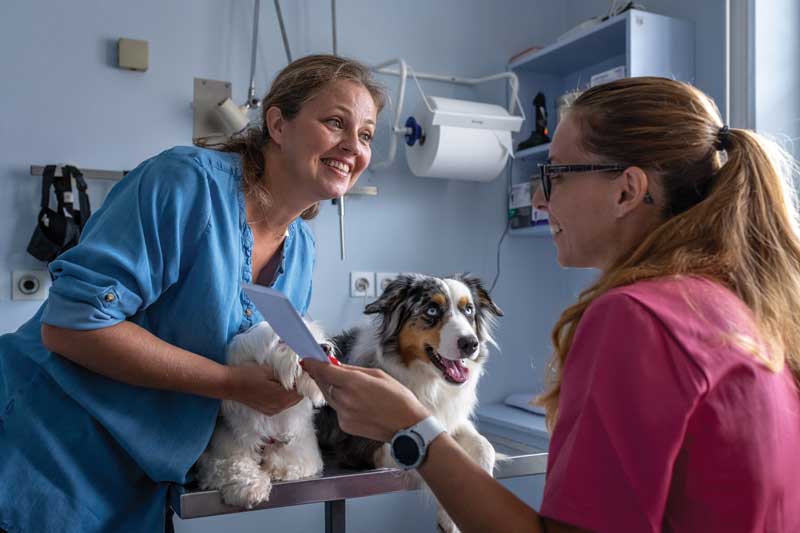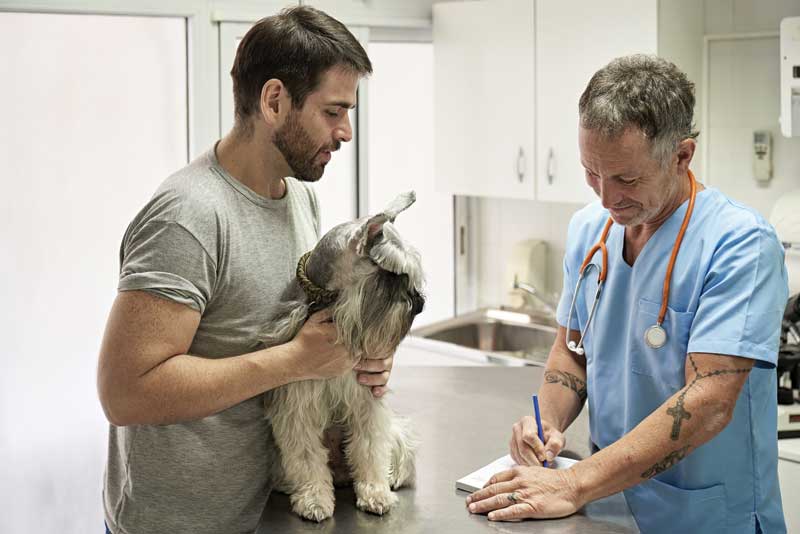Veterinarians are one of the few medical professionals who both prescribe and dispense medications. While veterinary clinics have been the primary source for prescription products historically, online pharmacies and brick-and-mortar retail pharmacies are common sources for pet owners to obtain prescription products.
Currently, veterinary clinics hold 71 percent of the pet prescription market, which was over $12 billion in 2022.1 One concern of veterinary professionals when working with these external pharmacies is the risk of prescription errors that can have serious consequences for patients. These concerns can be reduced by building interdisciplinary working relationships between veterinarians and pharmacists, which will ultimately benefit patients, clients, and veterinary professionals.
Advantages to working with community pharmacies
Working with community pharmacies can benefit your clients, patients, and business. Cost and convenience are two major factors for clients in choosing where to obtain their pet’s medications. The convenience of leaving the veterinary hospital with medication in hand for an acute condition can be a bonus for clients, but cost can sometimes be a barrier.
For 25 percent of U.S. pet owners, an unexpected expense of $250 will create a financial hardship.2 Providing a prescription for a medication that may be available at a reduced cost through a local pharmacy could be the difference between a pet receiving a medication or not.
For long-term medications, monthly costs can add up over time and making regular trips to the veterinary hospital for medication pick-ups can become stressful depending on distance and practice hours. In these cases, utilizing community pharmacies may offer benefits of both cost and convenience.
Veterinarians should honor client requests to provide prescriptions to outside pharmacies based on the American Veterinary Medical Association’s (AVMA) Principles of Veterinary Medical Ethics.3
A common barrier to compliance is a client’s ability to administer medication to a patient. Providing alternative formulations, such as liquids, flavored chews, and transdermal medications can help to improve compliance. Often, these products are not commercially available and must be compounded. Some community pharmacies offer compounding services, and veterinarians could consider partnering with them.4,5 Independent pharmacies may be more likely to have compounding services than larger chain pharmacies.
Before choosing to use a local pharmacy for compounding, it is essential to have a discussion with the pharmacists about what they can compound and their knowledge of veterinary compounding. For instance, not all medications are absorbed transdermally, and pharmacists at reputable compounding pharmacies should be able to guide clinicians on appropriate formulation options for individual medications.
Finally, the clinic’s bottom line can be improved with careful inventory management. Inventory is typically the second largest expense in a veterinary hospital.6
Choosing to stock medications that are filled commonly—such as common antibiotics, pain medications, and preventatives—is important, but consider eliminating medications that are used more rarely and providing a prescription instead. This will help to control inventory costs, save shelf space, and eliminate the risk of these lesser used medications expiring on your shelf.
Additionally, stocking and dispensing controlled substances, such as phenobarbital, can create additional inventory management challenges in maintaining Drug Enforcement Administration (DEA) compliance. Choosing to script out these medications instead of stocking them in-house can help to avoid these headaches.

a pet receiving a medication or not.
Community pharmacy relationship obstacles
Despite the many potential advantages to working with community pharmacies, many veterinarians have reservations about using external sources for pet medications. The two major factors contributing to this concern include frustrations in communicating with pharmacies and concern for prescription errors.
One of the most common frustrations when prescribing to a community pharmacy is requests for National Prescriber Information (NPI) or DEA numbers. NPI numbers are often requested by pharmacies, and they indicate eligibility to prescribe for Medicare and Medicaid. Since veterinary patients are not eligible for these programs, veterinarians are not eligible for this identification number.
Not all veterinarians have DEA numbers, and both the DEA and AVMA oppose the use of the DEA number as an identification for non-controlled substances.7,8 Ultimately, a state license number is a valid identifier when prescribing a non-controlled substance, though computer systems at individual pharmacies can make inputting these numbers challenging.
Significant prescription errors have been documented in several surveys by veterinary medical associations (VMAs). Across surveys performed by five different state VMAs, approximately one-third of veterinarians knew of cases where the wrong medication was dispensed or a medication was changed by a pharmacist without consulting the prescriber.9
While many of these cases did not result in patient harm, approximately 10 percent of responding veterinarians had experienced errors that resulted in patient harm.9 Many of these surveys were performed a decade ago, and more recent data is difficult to find, though anecdotal reports of prescription errors are seemingly common.
Understanding why these errors occur is essential, and veterinarians must remember there is no malicious intent if errors occur. Pharmacists are highly educated professionals who have legal obligations to verify all prescriptions they receive for accuracy and validity and counsel clients on potential side effects and drug interactions.10
Many pharmacists do not receive training in veterinary pharmacology during their schooling.5,11 Given there can be significant species-specific differences in dosing and/or side effects, pharmacists may not have the knowledge to accurately assess veterinary prescriptions and counsel clients.5
While there has been growing awareness of this knowledge gap, change in educational systems takes time. Until there is incorporation of veterinary pharmacology into the curricula at pharmacy schools, veterinarians should remain aware of this potential limitation and be open to discussing prescriptions with pharmacists to maximize patient safety.
Importance of communication
Use of community pharmacies as a source of pet prescriptions is not going away, and does have potential benefits. In order to improve outcomes, it is essential veterinarians and pharmacists find ways to build relationships.
In a recent survey of veterinarians and pharmacists in Ohio, there was an overall desire for collaboration and recognition in members of both professions of the need for better education around veterinary pharmacy.5
There are many ways veterinarians can help build relationships with community pharmacies, and it starts with communication.10 Veterinarians can contact local pharmacies and encourage the pharmacists to reach out with questions. When pharmacies do contact the clinic to verify a dosage or discuss a concern with the prescription, it is essential veterinary team members who are fielding these calls remain collegial in their communication. Pharmacists who are met with irritation, annoyance, and rude communication may be deterred from calling again in the future.
Additionally, when the inevitable request for an NPI or DEA number comes through, be consistent in your response, and consider educating the pharmacy team member on why you cannot or will not give out these numbers.
When veterinarians take the time to engage in open communication and education, they can benefit outcomes for multiple patients. Clinics can consider providing a written handout to local pharmacies as a quick reference for common problems. (See: “Make a list”)
Finally, veterinarians can consider donating an old copy of a drug reference, such as Plumb’s, to their local pharmacy. While the National Association of Boards of Pharmacy (NABP) recommends including a requirement for pharmacies to provide access to a veterinary drug reference in their model practice act, this recommendation has not been implemented in many states.11 If pharmacists have access to a veterinary drug reference, they can more easily verify dosages and check species-specific drug interactions and side effects to better counsel clients, which can also cut down on the need for them to call and verify prescriptions.
Make a listClinics can also consider providing a handout with key education points, which might include: |
Remember, veterinarians have unique ways to use human medications in patients, such as administering desmopressin nasal drops in the eye or opening diltiazem extended release capsules and administering the tablets contained within to dose small patients. It is no wonder pharmacists sometimes question our prescriptions, and we should appreciate that they take the time to perform their due diligence to ensure positive patient outcomes.

patient record, which can be consulted if an error occurs.
Preventing errors
Veterinarians can take steps to reduce the chance of prescription errors. Legibly written prescriptions may be one of the best ways to avoid miscommunications with a pharmacy and allow the veterinary team to keep a copy in the patient record, which can be consulted if an error occurs.
Prescription requirements vary by state, but patient weight is an important piece of information that can help pharmacists to verify accurate dosing. Many veterinarians do not include this in their prescription information.13 Updating your prescriptions to include this information can help to prevent errors and allow pharmacists to double check dosing accuracy if they have access to a veterinary drug reference.
If a prescription is phoned in to the pharmacy, the best way to prevent errors is to speak to a live pharmacy team member instead of leaving a message. While a veterinary team member can document the information they left on the pharmacy machine in the record, there is no way to know if the prescription was transcribed correctly at the pharmacy. An additional benefit to speaking to a live person is the ability to have them repeat the order back to verify accuracy. Additionally, for medications with “look-alike-sound-alike” names such as azithromycin and azathioprine and ketoconazole and ketoprofen, it can be useful to spell out the medication name to ensure the correct medication is dispensed.
Regardless of how strong the working relationship between veterinarian and pharmacist is, veterinarians can also protect their patients from prescription errors with clear client communication. Consider including the name, strength, and instructions of medications in written discharge instructions so that clients can double-check that the medication label matches. Veterinary teams can also provide clients with veterinary-specific information on potential side effects and advise them of any major species-specific differences that a pharmacist might comment on.
The future of collaboration
Having a strong relationship with a community pharmacy can help to improve client satisfaction, patient care, and the bottom line of your veterinary practice. While there are certainly frustrations that may occur and a potential for prescription errors, investing time in building interprofessional relationships can help to reduce these risks. With growing awareness of the need for better education on veterinary prescription issues for pharmacists, improved outcomes are likely to be seen
with time.
Kate Boatright, VMD, is a small animal general practice and emergency veterinarian, speaker, and author in Western Pennsylvania. Dr. Boatright enjoys discussing mentorship, the spectrum of care, well-being, communication, and professional collaboration. In March 2023, Boatright published the Veterinary Mentorship Manual, a resource for practices to help guide them in developing solid mentorship programs to support new graduates. In her remaining time, she stays busy chasing her toddler, running, reading, and watching movies with her husband, son, and cats.
References
- Fredonia Group. Pet medications in the US, 8th edition. Available at https://www.freedoniagroup.com/packaged-facts/pet-medications-in-the-us. Accessed September 30, 2023.
- Synchrony. Lifetime of care study. Available at http://petlifetimeofcare.com. Accessed September 30, 2023.
- AVMA. Principles of veterinary medical ethics. Available at https://www.avma.org/resources-tools/avma-policies/principles-veterinary-medical-ethics-avma. Accessed September 30, 2023.
- Bennett SA, Ruisinger JF, Prohaska ES, Steele KM, Melton BL. Assessing pet owner and veterinarian perceptions of need for veterinary compounding services in a community pharmacy setting. Pharm Pract (Granada). 2018 Jul-Sep;16(3):1224. doi: 10.18549/PharmPract.2018.03.1224.
- Fredrickson ME, Terlizzi H, Horne RL, Dannemiller S. The role of the community pharmacist in veterinary patient care: a cross-sectional study of pharmacist and veterinarian viewpoints. Pharm Pract (Granada). 2020 Jul-Sep;18(3):1928. doi: 10.18549/PharmPract.2020.3.
- Halow B. How do you manage inventory in a veterinary practice? Available at https://www.bashhalow.com/how-do-you-manage-inventory-at-a-veterinary-practice/. Published Jun 9, 2020. Accessed September 30, 2023.
- DEA. Practitioner’s Manual Section II: General Requirements. Retrieved from https://www.in.gov/dhs/files/DEA_Practicioner_Manual.pdf. Accessed October 1, 2023.
- AVMA. Inappropriate requests for Drug Enforcement Administration (DEA) Registration Numbers. Available at: https://www.avma.org/resources-tools/avma-policies/inappropriate-requests-drug-enforcement-administration-dea-registration-numbers. Accessed October 1, 2023.
- Cima G. Substitution errors: surveys describe harm from differences between prescriptions and drugs dispensed. JAVMA 2014;245(5):462-65.
- Boatright K and Forsythe L. Why—and how—to build relationships with community pharmacists. dvm360 Nov 2020;51(11). Available at https://www.dvm360.com/view/why-and-how-to-build-relationships-with-community-pharmacists. Accessed October 1, 2023.
- Young NW, Royal KD, Park M, and Davidson GS. Pharmacists’ knowledge of veterinary pharmacotherapy and the impact of of an educational intervention. J Pharm Tech 2018;34(6):244-251. https://doi.org/10.1177/8755122518794023
- Plumbs. National association of boards of pharmacy (NABP) calls for pharmacies to have “ready access” to a veterinary drug reference. Available at https://plumbs.com/blog/national-association-of-boards-of-pharmacy-calls-for-pharmacies-to-have-ready-access-to-a-veterinary-drug-reference/. Published October 27, 2015. Accessed October 1, 2023.
- McDaniel M, Glazier E, Truong N, et al. Veterinary prescription errors in a community pharmacy setting: a retrospective review. JAPhA 2022;62(2):512-518. https://doi.org/10.1016/j.japh.2021.11.007.

